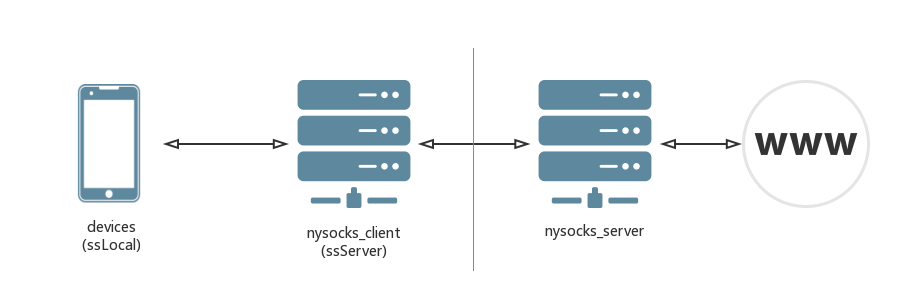
使用简介
Nysocks binds kcp and libuv to provide a tcp tunnel in nodejs. Nysocks clients support both SOCKS5 and SS protocols.
Nysocks is in an early stage. Please submit PRs or issues to help us improve it if you like it!
How it works
for SOCKS client
for SS client

protocol(unstable):
+-----+-----+---------+-------+---------+--------+------------+
| ver | cmd | nonce | kcp | mux.cmd | mux.id | mux.length |
+-----+-----+---------+-------+---------+--------+------------+
| 1 | 1 | 8 | 24 | 1 | 2 | 4 |
+-----+-----+---------+-------+---------+--------+------------+
About the Tunnel Implementation
The tunnel connections in nysocks is implemented as a node-addon(C/CPP) mainly because:- Node don't support setting send/recv buffer size of udp connections before v8.7.0.
- In large data transmissions, udp message callback is too frequently and manipulating buffers in js(or any other script languages) is relatively expensive which would make the total performace unacceptable. You can check my pure js implementation here.
Installation
node >= 6.xMake sure you have node-gyp installed successfully as nysocks will build C/CPP code, then:
npm i nysocks -g
Usage
1. Create server service
In your server, start nysocks withserver command:nysocks server -p 20000 -k YOUR_PASSWORD -m fast
2. Create client service
In your client, start nysocks withclient command to create a tunnel client that will connect to your server and provide proxy service:nysocks client -a YOUR_SERVER_HOST -p 20000 -k YOUR_PASSWORD -m fast
1080). A PAC file server will also be served(default port 8090) for convenience.Use SS Protocol
Nysocks supports using shadowsocks protocol to replace SOCKS5 protocol in your client:
nysocks client -a YOUR_SERVER_HOST -p 20000 -k YOUR_PASSWORD -m fast --client_protocol SS --ss_password YOUR_SS_PASSWORD --ss_method aes-128-cfb
3. Use config.json
You can create a config.json file like this that containing your configs to avoid verbose cli options:nysocks client -c config.json
4. Use daemons
Add-d options if you want to run under daemons(pm2):nysocks client -d restart -c config.json
5. Check other options
Modify your options in the CLI. See other options here:nysocks -h
Configs
CLI:nysocks <command>
Commands:
nysocks server Start a tunnel server.
nysocks client Start a tunnel client.
Options:
--version Show version number [boolean]
--config, -c The path of a json file that describe your
configuration.
--daemon, -d Run with a daemon(pm2): start, stop, restart.
--daemon_status, -s Show daemoned(pm2) processes status
--mode, -m Like kcptun: normal, fast, fast2, fast3.
--password, -k The passowrd/key for the encryption of transmissio.
--socket_amount The amount of connections to be created for each
client (default: 10)
--server_addr, -a The host of your server.
--server_port, -p The port of your server.
--client_protocol, --cp The protocol that will be used by clients: SS, SOCKS
(default: SOCKS)
--socks_port Specify the local port for SOCKS service (default:
1080)
--ss_port Specify the local port for ssServer service (default:
8083)
--ss_password Specify the key for the encryption of ss
--ss_method Specify the method of the encryption for ss (default:
aes-128-cfb)
--log_path The file path for logging. If not set, will log to
the console.
--log_memory Log memory info.
--log_conn Log connections info.
--help Show help [boolean]
config.json example:{
"serverAddr": "YOUR_SERVER_HOST",
"serverPort": 20000,
"socketAmount": 20,
"password": "YOUR_PASSWORD",
"kcp": {
"sndwnd": 1024,
"rcvwnd": 1024,
"nodelay": 0,
"interval": 30,
"resend": 2,
"nc": 1
},
"pac": {
"pacServerPort": 8090
},
"clientProtocol": "SOCKS",
"SOCKS": {
"port": 1080
},
"SS": {
"password": "YOUR_SS_PASSWORD",
"method": "aes-128-cfb",
"serverPort": 8083,
}
}How to utilize the SOCKS5 service
Most OSes support SOCKS5 proxy by default:
Use chrome extensions like SwitchyOmega to help browse web pages by proxy.
How to utilize the SS service
Install clients in your devices and connecting to the ssServer set up by nysocks.Encryption
aes_256_cbcKnown Issues
- Do not support ipv6 currently.
- Changing the ip of the client will disconnect all the connections temporary.
References
- kcptun - A Secure Tunnel Based On KCP with N:M Multiplexing
- kcp - A Fast and Reliable ARQ Protocol
- C++ and Node.js Integration